Australian Corps Memorial Park, Le Hamel
The Australian Corps Memorial Park is situated on the brow of a hill east of Le Hamel village to the south of the River Somme. The memorial park commemorates over 100,000 Australians who served with the Australian Corps in France during the First World War. The Australian Corps was formed in 1917. It comprised five Australian Divisions which saw service in Belgium and France from 1916-1918.
The memorial is located on the site of the final objective of the Battle of Hamel on 4th July 1918. This was the first attack planned and carried out by General Sir John Monash, commander of the Australian Corps.
Along the path to the memorial visitors will see numerous information panels with text, maps and illustrations to tell the story of the successful Battle of Hamel by ten Australian battalions and attached American units in the early morning hours of 4th July 1918.
The Memorial
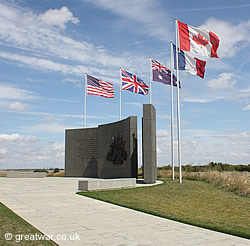
|
The land on which the memorial park is to be found was a gift to the Australian people by the Government of France. It was given to mark the 80th anniversary of the Battle of Hamel, which marked the turn of the tide for the Allies after the difficult period in the months of March and April 1918 following the German advances as far as Villers-Bretonneux with their Operation Michael offensive.
The memorial is constructed as three blocks of curved granite set in a semi-circle. The Australian Forces badge is in the centre block. A speech by Georges Clémenceau is to be found in English and French on each of the blocks to the left and right of the central block.
Official Rededication
The Australian Corps Memorial Park at Le Hamel was officially rededicated on 8th November 2008 by Her Excellency Ms Quentin Bryce, AC, Governor-General of the Commonwealth of Australia.
The memorial is maintained by the Commonwealth War Graves Commission.
Speech by Georges Clémenceau, 7 July 1918
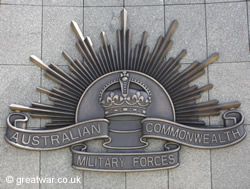
|
The wording on the memorial in French and English is taken from a speech by Georges Clémenceau, Président du Conseil (French Prime Minister), made on 7th July 1918 after the success by the Australians. The text reads as follows:
“A l'arrivée des troupes australiennes en France, le peuple français attendait beaucoup de vous. Nous savions que vous alliez mener une véritable bataille, mais nous ignorions que dès la première heure l'Europe entière serait impressionée. Demain, je dirai à mes compatriotes: j'ai vu les Australiens. Je les ai regardés dans les yeux. Je sais que ces hommes combattront à nos côtés jusqu'à ce que les valeurs que nous défendons tous l'emportent pour nous et nos enfants.”
“When the Australians came to France, the French people expected a great deal of you... We knew that you would fight a real fight, but we did not know that from the very beginning you would astonish the whole continent... I shall go back tomorrow and say to my countrymen, I have seen the Australians, I have looked in their faces, I know that these men will fight alongside of us again until the cause for which we are all fighting is safe for us and for our children.”
The Battle of Hamel

General Sir John Monash, Commander of the Australian Corps, planned for an attack to dislodge the German position on the spur of high ground where the granite memorial now stands. The frontage of the attack was about 3 miles wide from Villers-Bretonneux village in the south to Le Hamel in the north, with Vaire and Le Hamel woods between these villages.
Monash prepared the Australians' offensive to be one of complete surprise to the Germans. It was to be the first modern battle where the combined arms of infantry, tanks, artilery and air support would fight successfully together. Aircraft of the Royal Flying Corps and the Australian Flying Corps were used by Monash in this battle to resupply the ground troops with ammunition dropped by parachute. The aircraft also bombed craters in the open ground ahead of the assaulting infantry to give them some cover in the craters as they advanced. They flew constantly during the night of 3rd July over the German trenches to disguise the noise from the tanks as they moved up to the front to form up for their attack.
1,000 American troops were designated to be attached to the Australian Corps for the battle. General Monash selected the date of the attack as 4 th July as American Independence Day for the date of the attack in honour of the American involvement in this battle.
At 3.02am the artillery fired a smoke screen for the Australian and American infantrymen. This was the end of a series of artillery bombardments of smoke and gas during the build-up to the attack. The gas shells had compelled the Germans to repeatedly put on their gas masks. With the smoke screen at 3.02am they also assumed that it would be a bombardment with gas shells too, and many put on their gas masks.
At 3.10am the artillery started up a creeping barrage for four minutes. At precisely 3.14am, just as dawn was beginning to break, the Australian battalions left their trenches, following behind the barrage. They advanced towards the German Front Line. A German trench called Pear Trench on the British Army maps put up a tough defence. The advancing infantry had a difficult fight in the village of Le Hamel.
The attack was a great success, with the objectives reached by the Australian Corps by 04.35am, exactly 93 minutes from the start of the artillery smoke screen at 3.02am.
German casualties numbered about 2,000, with another 1,600 taken prisoner. Australian casualties were about 1,400 of whom about 250 were killed.

Two Victoria Crosses
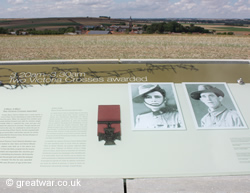
|
Private Henry (Harry) Dalziel, VC
Private Henry (Harry) Dalziel was in action with a Lewis machine gun in front of Pear Trench in the early hours of 4th July 1918. At the age of 25 he was awarded the Victoria Cross for his actions on that day.
The citation for No. 1936 Driver Henry Dalziel was published in the London Gazette dated 17th August 1918:
“For most conspicuous bravery and devotion to duty when in action with a Lewis gun section.
His company met with determined resistance from a strong point which was strongly garrisoned, manned by numerous machine guns, and undamaged by our artillery fire, was also protected by strong wire entanglements. A heavy concentration of machinegun fire caused many casualties, and held up our advance.
His Lewis gun having come into action and silenced enemy guns in one direction, an enemy gun opened fire from another direction. Private Dalziel dashed at it, and with his revolver killed or captured the entire crew and gun, and allowed our advance to continue. He was severely wounded in the hand, but carried on and took part in the capture of the final objective.
He twice went over open ground under heavy enemy artillery and machine-gun fire to secure ammunition, and though suffering from considerable loss of blood, he filled magazines and served his gun until severely wounded through the head. His magnificent bravery and devotion to duty was an inspiring example to all his comrades, and his dash and unselfish courage at a most critical time undoubtedly saved many lives and turned what would have been a severe check into a splendid success.” (1)
Lance Corporal Thomas (Jack) Axford, VC, MM
Lance Corporal Thomas (Jack) Axford, MM, was awarded the Victoria Cross for his action in the task of clearing Vaire and Hamel Woods of the German defenders. He enabled a platoon which was being held up by German machine gunners to move forward again. Single-handedly he got into the German trench and took the machine gunners on. He killed 10 of them and six were taken prisoner by his battalion. Lance Corporal Axford was 24 years old.
The citation for No. 3399 Lance Corporal Axford, VC, MM, was published in the London Gazette dated 17th August 1918:
“For most conspicuous bravery and initiative during operations.
When the barrage lifted and the Infantry advance commenced, his platoon was able to reach the first enemy defences through gaps which had been cut in the wire. The adjoining platoon being delayed in un-cut wire, enemy machine guns got into action, and inflicted many casualties, including the Company Commander. Lance-Corporal Axford, with great initiative and magnificent courage, at once dashed to the flank, threw his bombs amongst the machine-gun crews, jumped into the trench, and charged with his bayonet. Unaided he killed ten of the enemy and took six prisoners: he threw the machine guns over the parapet, and called out to the delayed platoon to come on. He then rejoined his own platoon, and fought with it during the remainder of the operations.
Prior to the incidents above mentioned he had assisted in the laying out of the tapes for the jumping off position, which was within 100 yards of the enemy. When the tapes were laid he remained out-as a special patrol to ensure that the enemy did not discover any unusual movement on our side. His initiative and gallantry undoubtedly saved many casualties, and most materially assisted towards the complete success of his company in the task assigned to it.” (2)
US Medal of Honour
Corporal Thomas Pope
Corporal Thomas Pope, serving with Company E of 131st Infantry, 33rd United States Infantry Division, was the first American soldier to be awarded the Medal of Honour in the First World War. He won the award for his actions in the attack at Le Hamel on 4th July. The citation for his Medal of Honour award is as follows:
“His company was advancing behind the tanks when it was halted by hostile machinegun fire. Going forward alone, he rushed a machinegun nest, killed several of the crew with his bayonet, and, standing astride [this] gun, held off the others until reinforcements arrived and captured them.” (3)
Trench Remains
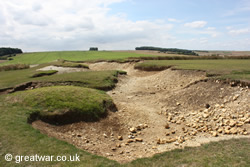
|
The remains of a section of trench, left in place after the war, has been incorporated into the memorial site and preserved in memory of those who fought in this place.
The Germans called this section Wolfsberg. Once the Australians had captured this ground on the morning of 4 July they stayed here for about five weeks until the launch of the next phase of operations, the 8 August Allied offensive to push the Germans to the east.
In the early morning of 8 August, just before dawn, the Canadian Corps, Australian Corps and III British Corps launched an Allied offensive along a 14 mile front from Moreuil in the south, Le Hamel in the centre and Albert in the north of the sector of battlefront. The battle, named the Battle of Amiens, was a major success for the Allies, leading to a large number of German casualties and prisoners, and a serious psychological blow to the Imperial German Army commanders. 8 July became known as The Black Day - Der Schwarze Tag - for the German Army. It was the beginning of the end for the German Army on the Western Front, as it was the start of a 100 day offensive by the Allied Armies resulting in the eventual final defeat of the German Army and the agreement to end the war with an armistice on 11 November 1918.
Location of the Le Hamel Memorial
The memorial is situated on a site to the east of the D71 at Le Hamel village. Signs from the D71 (Rue des Anges) direct visitors to the single track road called Chemin de Saily Laurette leading to the memorial car park.
Vehicle Access
Vehicle access to the memorial is restricted to the times as follows:
- 1 April - 31 October: open 09.00 - 18.00
- 1 November - 31 March: open 09.00 - 16.00
Vehicles requiring access outside these hours can contact the mayor of Le Hamel on 03.22.96.88.06
Parking
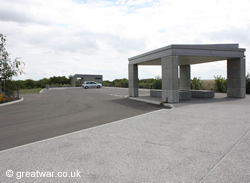
|
There is ample free parking for cars and coaches.
Picnic Facilities
Visitors are welcome to use the picnic facilities provided and are reminded to keep the area free of litter.
Toilet Facilities
Related Topics
Villers-Bretonneux Australian National Memorial
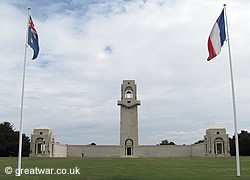
|
Franco-Australian Museum, Villers-Bretonneux
Franco-Australian Museum, Villers-Bretonneux
Acknowledgements
(1) Supplement to the London Gazette, 17 August 1918, page 9660.
Website: www.thegazette.co.uk 17 August 1918 page 9660
(2) Supplement to the London Gazette, 17 August 1918, page 9660.
Website: www.thegazette.co.uk 17 August 1918 page 9660
(3) Citation in the US Army Center of Military History website for World War I Medal of Honor Recipients:
Website: www.history.army.mil Pope
